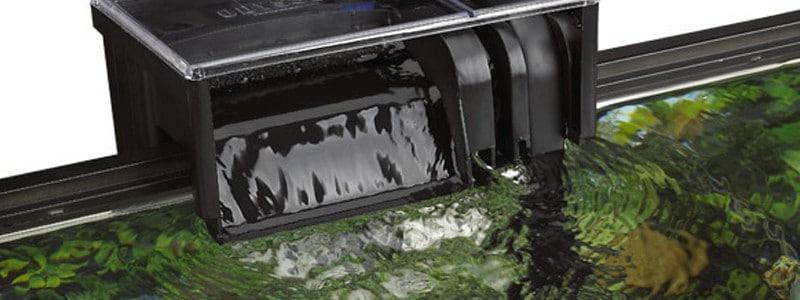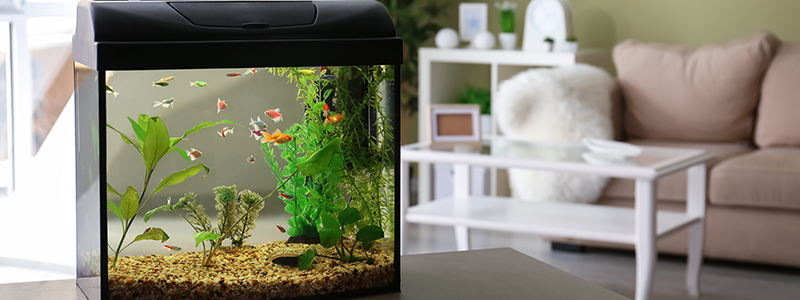When it comes to the substrate, there are lots of options out there. You could use anything from aquarium gravel, to soil, to glass pebbles–those smooth, round (and usually colorful) glass discs that get used in vases, fish tanks, and artwork. Today I’m going to look at using aquarium sand.
Can sand ruin aquarium filters? It’s possible–sand can get sucked up into the filter, and once there, it definitely doesn’t do any good. Most of the time, sand gets sucked into a filter during routine cleaning, water changes, or when adding plants or decorations (any time the bottom of the tank gets disturbed by something).
There are several not-so-great things sand can do to a filter, including:
- Clogging the filter
- Damaging or ruining the impeller
- Wearing down parts of the filter
I take a look at each of these in more detail below, and also cover why people would use sand, and ways to keep sand out of your filter in the first place.
What Sand Can Do to a Filter
Most of the time, sand only causes extra work to keep a filter clean, but sometimes it can actually damage the filter.
Clog the Filter
While this is more of an inconvenience, if you don’t realize the filter’s getting clogged, your water quality is going to go downhill fast.
A clogged filter can’t pull up excess food or fish waste, meaning it all stays down in the tank, releasing harmful chemicals like ammonia and nitrites into the water as it decays.
If your filter has a biological medium, like a bio-wheel, that it runs water through before returning it to the tank, the biological medium could end up getting too clogged by sand to keep on working, too!
(Biological filters house lots of good bacteria that break ammonia and nitrites down into safe nitrates for your fish.)
I’ll show you a few ways to keep your filter from getting clogged up by aquarium sand later in this post.
Damaging or Ruining the Impeller
All power filters use an impeller (motor) to suck water up through the filter, past the carbon or other filtration device, and through a biological medium (if you have that type of filter) before returning the water to the tank.
If sand gets inside the filter, it can easily spread to the impeller and cause it to stop working.
This happens when sand gets stuck inside the moving parts of the filter and causes the impeller to stop turning.
If the impeller stops working, your filter stops pulling up water from the tank, and you’ll have to buy a replacement impeller (if you can find one) or a whole new filter.
This is a big reason why some power filter manufacturers recommend using gravel, pebbles, or glass pebbles instead of sand for a substrate.
Wearing Down Filter Parts
Even if sand doesn’t reach the filter’s impeller, it can still damage the internal parts of a filter by grinding down the plastic or other materials the filter is made of.
If the filter parts get worn down, the filter won’t work as well, and you could start having issues with your water quality, as mentioned above.
It could even start leaking if small holes get worn into the filter housing, which will also affect how well your filter works, besides getting water all over your floor.

Why Use Sand in a Fish Tank?
If sand can cause so many problems with filters, why use it at all?
There are several good reasons to use sand over gravel. Some bottom-feeding or bottom-dwelling fish can be easily cut on sharp bits of gravel. This can be especially true for fish with barbels or with softer stomachs. For these fish, sand is a better option.
Some live aquarium plants actually prefer sand as a substrate, and grow better in it than they would in gravel.
And, you may be surprised to learn that there are some fish that actually use sand to help them eat their food!
In addition, some people just like how it looks better than gravel or other options. It may look more natural to use sand if you’re trying to make your aquarium look like the fish’s natural habitat would.
If you’re using glow-in-the-dark decorations or the kind based on cartoon characters, this probably wouldn’t be much of a factor, but for someone using live plants, driftwood, rocks, and natural-looking decorations, sand might complete the natural image they’re going for.
When You Shouldn’t Use Sand
With all that said, there are a few times you’re better off not using sand in your aquarium.
If you use an under-gravel (or under-substrate) filter you should never use sand in your aquarium, since there will be no way to keep the filter from sucking up the sand sitting on top of it.
If you have active fish that like to stir up the sandy bottom of the aquarium, and you don’t have a way to keep them from disturbing the sand near your filter, then sand is probably not the best option for your tank, unless you take additional precautions like using a sponge filter.
In addition, if you have live aquarium plants that need a deep substrate to take root, then sand isn’t your best option.
For owners of acrylic tanks, you need to be aware that sand can scratch your tank’s surface, especially if you use magnets to clean algae off the sides of the tank and any sand gets between the magnet and tank wall.
How to Keep Aquarium Sand Out of the Filter
There are several ways you can keep your filter free of sand (or mostly free of sand) and the good news is they’re not that hard to do.
Use a Sponge Filter
This could be as simple as taking a sponge and cutting it to fit the inside of your intake tube, or even taking zip ties and tying it to the outside of the filter intake.
This way, the sponge will stop sand from getting into the filter, while still allowing the filter to do its job and suck up water.
You may need to remove the sponge from time to time to clean it, or even replace it with a new sponge once in a while.
Sponge filters can also be bought at many local fish stores, and you may find one already pre-cut to fit your existing filter.
Use Stockings/Pantyhose
For the do-it-yourselfer out there, you could use thin stockings or pantyhose almost like a sponge filter.
You would simply cut the stocking or pantyhose to fit the end of your filter’s intake tube, and either zip-tie or rubber-band it onto the filter to keep it from getting sucked in.
This will also prevent sand from getting in and allow the filter to do its job of pulling up the water and cleaning it before returning it to the tank.
Check Your Filter Placement
If you want to use sand in your tank, the general rule of thumb is to be sure the filter intake is at least 4 inches above the sandy substrate. This will help minimize the amount of sand that gets sucked into the filter.
Turn Off the Filter Before Stirring Up the Substrate
Whenever you’re about to do anything that stirs up your sandy aquarium substrate, go ahead and turn off the filter first. That way, it won’t suck up any sand that gets moved around from doing any of the following:
- Cleaning the sand
- Adding new water to the tank
- Adding new plants and decorations to the tank, or taking them out of the tank
- Moving things around in your tank
Once you’ve finished, wait for the sand to settle down again before turning the filter back on.

Alternatives to Sand
If you really like the idea of sand, but are worried about your filter, you can always choose some natural-looking alternatives, like smooth pebbles, which would also be safe for delicate fish.
If you’re not worried about maintaining a natural look in your aquarium, glass pebbles could also be a good alternative, since they’re also very smooth, too large to go anywhere in the tank, and come in a variety of colors.
In Summary
Sand can make a fish tank look more natural, make the tank safer for certain kinds of fish, and be a better substrate for live aquarium plants than things like gravel. But, sand can create problems for filters, like:
- Clogging the filter
- Damaging the impeller
- Wearing down filter parts
Thankfully, there are a few things you can do to keep sand out of your filter, like adding a sponge filter, using stockings or pantyhose for the same effect, placing your filter at least 4 inches above the sand layer, and turning your filter off whenever you’re about to do anything that will stir the sand up.
Be aware, however, that if you have an under-gravel filter, you should not use sand in your tank, and sand can easily damage acrylic tank walls when cleaning.
Related Topics
If you like the article above, here are some other similar articles you should check out!
Can you Turn Off an Aquarium Filter at Night?
Best Aquarium Filters: A Buyer’s Guide




